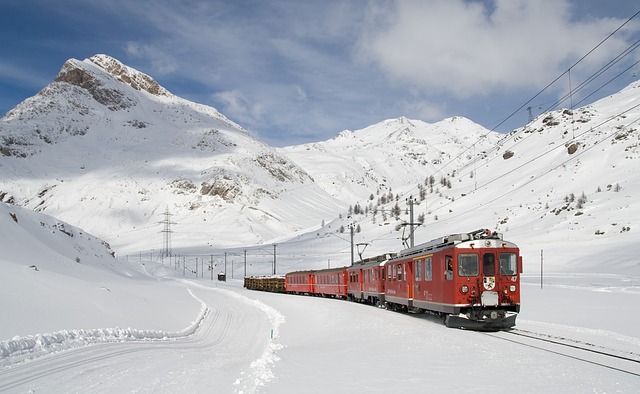Top 10 Largest Railway Network In the World
Here the list of top railway networks in the worlds
also read fifa world cup
1. United States of America (USA)
2. Russia
3. China
4. India
5. Canada
6. Germany
7. Australia
8. Argentina
9. France
10. Brazil
Top Countries of Railway
1. United States of America (USA) –
The United States of America has one of the most extensive railway networks in the world. The history of railroads in the U.S. dates back to the 19th century, and over time, it has grown into a vast and intricate system. Here are some key points about the railway network in the United States:
- Size and Extent: The U.S. railway network covers approximately 138,000 miles (222,000 kilometers) of track. It is a complex web of railroads that crisscross the country, connecting major cities, ports, industrial centers, and rural areas.
- Class I Railroads: The U.S. railway system is primarily operated by several large Class I railroad companies, including Union Pacific, BNSF Railway, Norfolk Southern, and CSX Transportation. These companies own and operate the majority of the rail infrastructure in the country.
- Freight Transportation: Railroads in the United States are primarily used for freight transportation. They play a crucial role in moving goods such as coal, grain, chemicals, automobiles, and consumer products across the country. Freight railroads are known for their efficiency and cost-effectiveness in transporting large quantities of cargo.
- Passenger Rail: While passenger rail service in the United States is not as extensive as in some other countries, there are still passenger trains operating on various routes. Amtrak is the national passenger rail service provider, operating long-distance and regional routes connecting major cities. Some cities also have commuter rail systems, like the Metro-North Railroad and the Long Island Rail Road in the New York metropolitan area.
- High-Speed Rail: The United States has been exploring the development of high-speed rail networks, but progress has been relatively slow compared to other countries. Several high-speed rail projects have been proposed, but only a few have reached the construction phase, such as the California High-Speed Rail project.
- Rail Safety: Safety is a significant concern in the U.S. railway industry. Measures and regulations are in place to ensure the safe operation of trains and the maintenance of rail infrastructure. Advances in technology, such as positive train control (PTC), have been implemented to enhance safety.
- Historical Significance: Railroads played a pivotal role in the westward expansion and industrialization of the United States in the 19th century. They facilitated the movement of people and goods, connecting the East Coast with the West Coast and enabling the growth of cities and industries.
- Private Ownership: Most of the U.S. railway network is privately owned and operated by railroad companies. These companies invest in maintaining and upgrading their infrastructure to meet the demands of modern transportation.
The U.S. railway network continues to be an essential part of the country’s transportation infrastructure, supporting the movement of goods and people across the vast expanse of the United States. Efforts to modernize and expand the network are ongoing, with a focus on improving efficiency, reducing environmental impact, and promoting sustainable transportation options.
2. Russia –
Russia had one of the most extensive railway networks in the world. The total length of Russia’s railway network was estimated to be around 290000 kilometers.
- Extent and Geography: Russia’s railway network spans across the entire country, connecting major cities, remote regions, and industrial centers. It is particularly extensive in the European part of Russia and extends into Siberia and the Far East. Due to Russia’s massive landmass, the railway network is essential for both domestic transportation and international trade.
- State Ownership: The majority of Russia’s railway infrastructure is owned and operated by the state-owned company Russian Railways (RZD or Rossiyskie Zheleznye Dorogi). RZD is responsible for maintaining and developing the railway system across the country.
- Gauge: Russia uses a broad gauge railway track, known as the Russian gauge or 1,520 millimeters (4 feet 11.8 inches). This gauge is wider than the standard gauge used in most countries, which is 1,435 millimeters (4 feet 8.5 inches). This difference in gauge can create challenges for international rail transportation between Russia and neighboring countries with standard gauge tracks.
- High-Speed Rail: While Russia has an extensive network of conventional railways, it has also invested in high-speed rail infrastructure. The Sapsan trains, for example, connect Moscow and St. Petersburg at high speeds, reducing travel time between these two major cities.
- Trans-Siberian Railway: One of the most famous railway lines in Russia is the Trans-Siberian Railway, which stretches over 5,700 miles (9,200 kilometers) from Moscow to Vladivostok. It is one of the longest railway lines in the world and plays a vital role in connecting European Russia with Siberia and the Russian Far East.
- Cargo Transportation: The Russian railway system is heavily used for transporting goods, including commodities such as oil, coal, metals, and various industrial products. It is a critical part of Russia’s economic infrastructure and contributes significantly to the country’s trade.
- Modernization: As of my last update, there were ongoing efforts to modernize and upgrade Russia’s railway infrastructure. This included the introduction of new technologies, improving the speed and efficiency of the rail system, and expanding the network where necessary.
3.China –
China has one of the most extensive and rapidly expanding railway networks in the world. The Chinese railway system is known for its high-speed trains, efficient transportation, and vast coverage of both passenger and freight services. The total Length of China’s railway network is approximately 86000 kilometers.
Here are some key points about China’s railway network:
- High-Speed Rail (HSR): China is a leader in high-speed rail technology. It has an extensive high-speed rail network connecting major cities across the country. Some of the most famous high-speed rail lines include the Beijing-Shanghai High-Speed Railway and the Beijing-Guangzhou High-Speed Railway, among others. These trains can reach speeds of up to 350 km/h (217 mph).
- Extensive Coverage: China’s railway network covers almost every province and autonomous region in the country, linking even remote areas to major cities. This extensive coverage helps facilitate economic development and passenger transportation.
- Investment and Expansion: China has been consistently investing in expanding its railway network. Major infrastructure projects are constantly underway to connect more cities, improve transportation efficiency, and promote economic growth.
- Freight Transportation: In addition to passenger services, China’s railway network plays a crucial role in transporting goods. It helps facilitate domestic and international trade, moving a significant volume of freight across the country.
- Belt and Road Initiative: China’s ambitious Belt and Road Initiative (BRI) includes the development of railway connections with neighboring countries to enhance regional connectivity. This initiative aims to strengthen economic ties and infrastructure development along ancient trade routes.
- Technological Advancements: China has developed its own high-speed train technology and exports it to other countries. The country has made significant advancements in railway technology, including maglev (magnetic levitation) trains.
- Ticketing and Booking: Ticketing and booking for Chinese trains have become more convenient with the introduction of online booking systems and mobile apps. Passengers can easily book tickets and check schedules.
4. India –
India has one of the largest railway networks in the world, operated by Indian Railways. The Indian Railways network is an extensive and complex system that plays a crucial role in the country’s transportation infrastructure. Here are some key points about the Indian Railway network. The Indian Railways network covers more than 85,000 kilometers of track, making it one of the most extensive railway networks globally.
- Overview: Indian Railways is a state-owned enterprise and is one of the largest railway systems globally. It is responsible for operating and managing the rail network in India.
- Broad Gauge: The majority of the Indian Railways network uses the broad gauge track, which has a track gauge of 1,676 mm. This gauge allows for higher speeds and larger loads compared to narrower gauges.
- Zones: Indian Railways is divided into several zones, each responsible for managing a specific geographic region of the country. These zones are further subdivided into divisions.
- Passenger and Freight Services: Indian Railways provides both passenger and freight services. It transports millions of passengers and tons of goods every day across the country.
- High-Speed Rail: India has also been working on introducing high-speed rail corridors, commonly referred to as bullet trains, to connect major cities. The Mumbai-Ahmedabad High-Speed Rail Corridor is one of the prominent projects in this category.
- Metro Rail Systems: Several Indian cities have also developed their own metro rail systems to address urban transportation needs. These metro systems operate alongside the mainline railway network.
- Heritage Railways: India is known for its heritage and tourist-oriented railways, such as the Darjeeling Himalayan Railway and the Nilgiri Mountain Railway. These narrow-gauge railways offer scenic journeys for tourists.
- Technological Advancements: Indian Railways has been adopting modern technologies, including computerized reservation systems, Wi-Fi-enabled trains, and improved signaling and safety systems.
- Challenges: The Indian Railways network faces challenges like congestion, the need for modernization, and safety concerns. Investment and infrastructure development are ongoing efforts to address these issues.
5. Canada –
Canada has an extensive railway network that plays a crucial role in the country’s transportation and economy. The Canadian railway system is one of the largest and most developed in the world. It spans across the vast and diverse landscape of Canada, connecting major cities, ports, and resource-rich regions. Here are some key aspects of Canada’s railway network: Canada’s railway network is extensive, with thousands of miles (or kilometers) of track spanning the country. However, it’s important to note that the exact length 46000 kilometers.
- Canadian National Railway (CNR): The Canadian National Railway is one of the two major freight railway operators in Canada. It is a transcontinental railway that stretches from the Atlantic Ocean in the east to the Pacific Ocean in the west. CNR also extends into the United States, connecting with various American railroads.
- Canadian Pacific Railway (CPR): The Canadian Pacific Railway is the other major freight railway in Canada. Like CNR, it is a transcontinental railway, running from the Atlantic to the Pacific. CPR played a significant role in the development of Canada as a nation in the late 19th and early 20th centuries.
- Regional Railways: In addition to the two major freight railways, Canada has several regional and short-line railroads that operate in specific provinces and regions. These railways serve local industries and communities and connect to the larger network.
- Passenger Rail: Canada also has passenger rail services, with VIA Rail being the primary provider. VIA Rail operates passenger trains that connect major cities and regions across the country, offering a scenic way to travel and explore Canada.
- Remote and Northern Railways: In the northern and remote areas of Canada, railways are essential for transporting goods and resources. These railways are often used for mining, forestry, and other resource-related industries.
- Ports and Transportation Hubs: Canada’s major ports, such as Vancouver, Montreal, and Halifax, are connected to the railway network. This connection allows for the efficient transport of goods between ports and inland destinations.
- Economic Importance: Canada’s railway network is vital to its economy, facilitating the transportation of a wide range of goods, including minerals, grain, forest products, and manufactured goods. It also plays a crucial role in trade with the United States and other countries.
- Challenges and Upgrades: Maintaining and expanding the railway network in Canada is an ongoing challenge due to the vast distances, harsh weather conditions, and the need for modernization. Investments in infrastructure and technology are continually being made to improve efficiency and safety.
6. Germany –
Germany had an extensive railway network with a total length of approximately 41,500 kilometers of track. Germany has one of the most extensive and well-developed railway networks in Europe. The German railway system is operated primarily by Deutsche Bahn (DB), the state-owned railway company, and several regional and private railway companies. Here are some key points about the railway network in Germany:
- High-Speed Rail: Germany has a network of high-speed rail lines known as the Intercity-Express (ICE) system. ICE trains connect major cities in Germany and also offer international connections to neighboring countries like France, the Netherlands, Belgium, Austria, and Switzerland. These trains can reach speeds of up to 320 km/h (200 mph).
- Regional Trains: In addition to high-speed services, Germany has an extensive network of regional trains. These trains serve smaller towns and cities, providing efficient transportation within regions.
- S-Bahn: Many major cities in Germany have an S-Bahn system, which is a suburban commuter rail network. These trains connect the city center with its suburbs and neighboring towns.
- U-Bahn and Trams: Most large German cities also have U-Bahn (subway) and tram systems for efficient urban transportation.
- Deutsche Bahn: Deutsche Bahn (DB) operates long-distance and regional train services. It is the largest railway company in Germany and offers a variety of ticket options, including discounts for students, seniors, and frequent travelers.
- Regional Railway Companies: In addition to DB, there are several regional railway companies that operate within specific states or regions of Germany. These companies provide local transportation services and connect smaller towns and rural areas.
- Ticketing: Germany offers various ticketing options, including single tickets, day passes, and rail passes for tourists. The Deutsche Bahn website and mobile apps provide information on schedules, fares, and ticket bookings.
- Rail Passes: Tourists can purchase rail passes like the German Rail Pass, which provides unlimited travel on consecutive days throughout Germany. These passes can be a cost-effective option for exploring the country by train.
- Punctuality and Efficiency: The German railway system is known for its punctuality and efficiency. Trains are generally reliable and well-maintained, making them a popular choice for both domestic and international travel.
- International Connections: Germany has extensive international rail connections, making it easy to travel to neighboring countries by train. Popular international routes include connections to France, the Netherlands, Switzerland, and Austria.
7. Australia –
Australia has a vast railway network that spans the entire continent. The country’s railways play a crucial role in transporting goods and people across the vast and often remote landscape. Here are some key aspects of Australia’s railway network. Australia’s railway network stretches for approximately 38,000 kilometers.
- Broad Gauge vs. Standard Gauge:
- Australia has a mix of railway gauges. The three main gauges are standard gauge, broad gauge, and narrow gauge.
- Standard gauge, with a track width of 1,435 mm (4 feet 8.5 inches), is the most common gauge used for long-distance freight and passenger services in the eastern and southern parts of Australia.
- Broad gauge, with a track width of 1,600 mm (5 feet 3 inches), is used in the state of Victoria.
- Narrow gauge is found in some regional and mining railways.
- Passenger Rail Services:
- Passenger rail services are provided by various operators across the country, including government-owned entities like Queensland Rail, Sydney Trains, and Public Transport Victoria.
- The Indian Pacific, the Ghan, and the Overland are famous long-distance passenger trains that traverse vast distances, connecting major cities.
- Freight Rail:
- Australia’s railway network plays a critical role in transporting bulk goods, including minerals, agricultural products, and containerized freight.
- Major freight operators like Aurizon, Pacific National, and SCT Logistics operate extensive freight rail services.
- The country has several dedicated interstate freight corridors to facilitate the movement of goods.
- High-Speed Rail:
- Australia does not have a high-speed rail network as seen in some other countries. However, there have been discussions and proposals for high-speed rail projects, primarily connecting major cities on the east coast.
- Urban Rail Systems:
- Major Australian cities have their own urban rail systems to provide public transportation within metropolitan areas. Examples include Sydney Trains, Melbourne’s Metro Trains, and Brisbane’s CityTrain network.
- Mining Railways:
- Given Australia’s significant mining industry, there are many private railways dedicated to transporting minerals and resources from mining sites to ports or processing facilities.
- Remote Railways:
- Some remote areas, such as the Australian Outback, are served by isolated railways, often used for transporting goods to remote mining operations or communities.
- Historical Railways:
- Australia has a rich history of railways, with many historic and heritage railways operating as tourist attractions.
- Future Developments:
- Various railway projects and upgrades are continually being planned and developed to improve rail infrastructure, capacity, and connectivity.
8. Argentina – Argentina has an extensive railway network, although its size and importance have decreased significantly over the years. The country’s railway system was once one of the largest and most advanced in the world, but it has faced numerous challenges and declines in the second half of the 20th century. As of my last knowledge update in September 2021, Argentina had an extensive railway network with a total length of approximately 36,966 kilometers (22,989 miles). This network covered various regions of the country, connecting major cities and serving both passenger and freight transportation.
Here is an overview of the Argentina railway network:
- History: Argentina’s railway system has a rich history, with its origins dating back to the 19th century. British companies played a significant role in building and operating many of the early railways in Argentina.
- Golden Age: The railway system reached its zenith during the early to mid-20th century, with an extensive network connecting cities and regions across the country. The railways played a crucial role in the economic development of Argentina, facilitating the transportation of goods and people.
- Decline: The decline of Argentina’s railways began in the mid-20th century due to various factors, including the rise of road transportation, political changes, and financial difficulties faced by the railway companies. The railway system gradually deteriorated, with many lines being closed, and services becoming less reliable.
- Nationalization: In the 1940s and 1950s, the Argentine government started to nationalize the railway companies. This process was completed in the 1950s, resulting in the creation of a state-owned railway company called Ferrocarriles Argentinos.
- Privatization: In the 1990s, the Argentine government, under President Carlos Menem, embarked on a privatization program that aimed to transfer control of the railway system to private companies. However, this process faced various challenges, including lack of investment and poor maintenance.
- Recent Developments: In recent years, there have been efforts to revitalize and modernize parts of the Argentina railway network. Some lines have been refurbished, and new rolling stock has been introduced. Notably, the Buenos Aires commuter rail network (known as the “Trenes Metropolitanos”) has seen improvements and expansions.
- Current Network: As of my last knowledge update in September 2021, Argentina’s railway network covers various regions of the country, connecting major cities and serving both passenger and freight transportation. Major lines include the Belgrano, San Martín, Roca, and Mitre lines. However, the network’s overall condition and coverage have not fully recovered to its past glory.
9. France – France has one of the most extensive and well-developed railway networks in Europe and the world. The French railway system is operated primarily by the state-owned company known as the Société Nationale des Chemins de fer Français (SNCF), which translates to the French National Railway Corporation. Here are some key points about the railway network in France: The total length of France’s railway network was approximately 29,273 kilometers (about 18,177 miles).
- High-Speed Rail (TGV): France is famous for its high-speed trains, known as TGV (Train à Grande Vitesse). The TGV network connects major cities and regions in France, as well as several international destinations. The TGV can reach speeds of up to 320 km/h (200 mph), making it one of the fastest train services in the world.
- Conventional Rail: In addition to high-speed rail, France has an extensive conventional rail network that serves both regional and long-distance travel. This network connects towns and cities throughout the country, including rural areas.
- Paris Metro: Paris, the capital of France, has an extensive metro system, which is one of the busiest in the world. It consists of multiple lines that crisscross the city and its suburbs, providing efficient transportation for residents and visitors.
- Regional Rail Services: France has a well-developed regional rail system known as the TER (Transport Express Régional). TER trains connect cities and towns within specific regions, providing essential transportation for daily commuters and travelers.
- International Connections: France’s railway network extends beyond its borders, connecting to neighboring countries like Belgium, Germany, Italy, Switzerland, Spain, and the United Kingdom. International trains, including the Eurostar and Thalys, allow for easy travel to and from France.
- Modernization: France has continued to invest in the modernization and expansion of its railway network. Projects like the LGV (Ligne à Grande Vitesse) extensions, which add more high-speed lines, have been ongoing to improve connectivity and reduce travel times.
- Tourist Trains: France also has several scenic and tourist trains, such as the Mont Blanc Express and the Train des Pignes, which offer travelers picturesque journeys through the French countryside and mountains.
- Freight Rail: France has a significant freight rail network, which plays a vital role in transporting goods across the country and to and from neighboring countries.
- Ticketing and Booking: Travelers can purchase tickets for French trains through various channels, including train stations, online platforms, and mobile apps. The SNCF website and mobile app are commonly used for booking tickets and checking train schedules.
Overall, France’s railway network is known for its efficiency, speed, and extensive coverage, making it a popular choice for both domestic and international travel within Europe.
10. Brazil – Brazil had an extensive railway network, although it had not seen as much investment and expansion as some other transportation modes like roads and air travel. The Brazilian railway network is managed by various public and private entities. Brazil’s railway network was approximately 29,000 kilometers (about 18,019 miles) in length. Here are some key points about the railway network in Brazil:
- History: Brazil’s railway system has a rich history dating back to the 19th century. The first railway in Brazil was inaugurated in 1854 in Rio de Janeiro, and railways played a significant role in the country’s economic development.
- Extensive Network: Brazil has a vast railway network, covering thousands of miles of track. The network connects various regions of the country, including the major cities and ports.
- Cargo Transportation: Railways in Brazil are primarily used for the transportation of freight, particularly bulk commodities like iron ore, soybeans, and grains. They are crucial for the country’s exports and industrial activity.
- Passenger Services: While the focus has been on cargo transportation, there are also passenger services in some parts of the country. These passenger trains often cater to tourists or specific regional needs.
- Ownership and Management: The Brazilian railway network is a mix of state-owned and privately operated railways. Some of the key players in the Brazilian railway sector include Vale, Rumo, MRS Logística, and América Latina Logística (ALL), among others.
- Investment and Modernization: In recent years, there have been efforts to modernize and expand the railway network. The government and private sector have been exploring opportunities to invest in new rail infrastructure and upgrade existing lines.
- Challenges: The railway sector in Brazil faces various challenges, including the need for significant investment to improve infrastructure, reduce bottlenecks, and enhance efficiency. Additionally, regulatory and logistical issues have sometimes hindered the full potential of the railway system.









